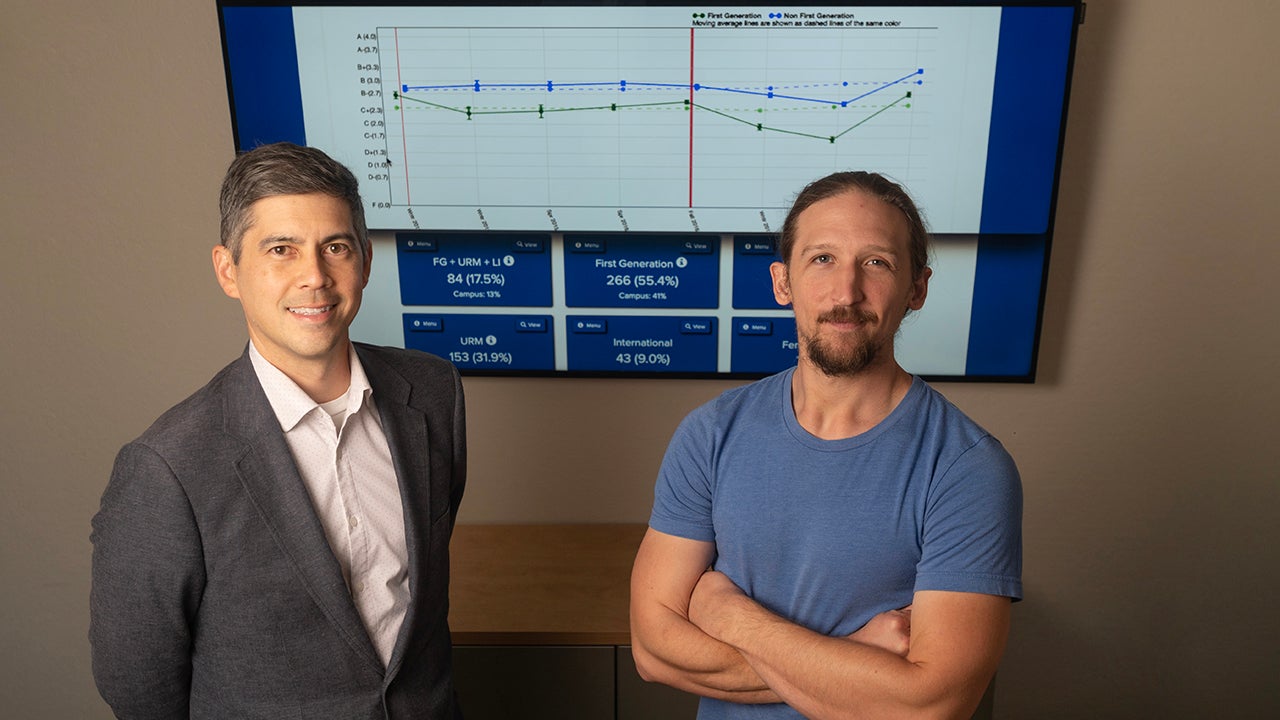Before instruction begins this fall, Laci Gerhart will give herself a head start in meeting the more than 900 students she will teach in two sections of an introductory biology course.
The associate professor of teaching in the Department of Evolution and Ecology will review her classes in Know Your Students, or KYS, a campus-grown tool that offers UC Davis instructors de-identified data on their students.
KNOW YOUR STUDENTS
- Visit the Know Your Students website.
- Attend Matt Steinwachs’ Zoom office hours on institutional data, educational research and analysis techniques noon to 1 p.m. on Wednesdays.
- Request an orientation for full access.
“I feel like I get a sense of what they’re doing and where they are,” said Gerhart, one of about 90 instructors with access to all the tool’s advanced features. “Know Your Students is most powerful in the large classes that need it the most.”
The Center for Educational Effectiveness began developing the web application in 2017 to give instructors more insight into who is in their class and how they are doing with the aim of helping instructors make positive interventions to improve equity and inclusion.
Encouraging use
The center shared KYS with a few instructors in the tool’s first few years and then made it available to all instructors when classes went remote during the pandemic.
Among instructors with basic access, 1,1017 have visited the site at least once, and 172 have visited it in the last year. Among those with full access, 76 have been to the site, and 41 have done so in the last year.
This academic year, the center aims to encourage more professors to use it through presentations at the orientation for new faculty Sept. 17, the Scholarship of Teaching and Learning Conference Dec. 10, and center workshops as well as new Zoom office hours with the developer.
KYS was developed with a $1 million grant over five years from the Howard Hughes Medical Institute’s Inclusive Excellence 1& 2 program to build support systems to encourage students of all backgrounds to participate and succeed in science.
Marc Facciotti, professor of biomedical engineering, was the principal investigator for the grant. “The initial targets [to use KYS] were instructors teaching large, typically introductory courses — courses that can often be barriers to academic progress for many students,” he said.

The tool provides aggregate student demographics and academic data at the class level as well as ways to examine and reduce inequities at the curricular, assignment and grading levels.
“It’s seen as bold for how much information we’re sharing,” said Matt Steinwachs, who developed KYS in his role as lead programmer for the center.
Two levels of access
COMMON USES
- Schedule office hours using a heat map to see when most students have free time in their class schedule.
- Tailor examples in lectures to specific disciplines by knowing the majors in a class.
- Know how much to reinforce foundational material by seeing how students fared in prerequisites.
- Gauge how consistently teaching assistants are grading by looking at grade distribution across course labs.
The basic version of KYS available to all instructors provides easy-to-read snapshots of the number of students, transfer students, academically distressed students, repeaters, their average number of quarters or semesters at UC Davis, and other campus-level data.
Those who meet with Steinwachs for an orientation session have access to much more information, still de-identified. This includes data on students who would be in the first-generation of their family to graduate from a four-year university; are from low-income regions; are from historically underrepresented groups; those for whom English is a second language; and self-identify as women. It also includes their majors; the number of units students are taking, and even the grade distributions of the cohort in prior courses.
The full version shows grade data separated by demographic categories; charts, graphs and other data visualizations highlight equity gaps in grades among the groups.
To address inequities
Kem Saichaie, executive director of the UC Davis center, said one purpose of the orientation is to check the temptation to allow the data to confirm any biases and instead reinforce its purpose for addressing inequities. “We want to make sure instructors understand how to use it responsibly and as a reflective tool to inform teaching practices,” he said.
Saichaie and Steinwachs emphasized that student privacy is paramount. Data is not linked to student names or other identifying information, and no data is presented where the number in a data group would be fewer than 10.
How it was developed
Steinwachs said the idea for KYS evolved from individual data and spreadsheet requests the center received from instructors.
Facciotti worked with a faculty advisory committee, and the project team consulted with representatives of the Academic Senate, the university registrar and provost as they worked through data governance, privacy and other issues. It took about three years to create the initial dashboard. Gerhart was one of about 30 beta users who provided feedback.
Steinwachs said he drew on information from the registrar’s office and Institutional Analysis. He has taken inspiration and a few features from the California State University’s Student Success Dashboard and the SEISMIC Collaboration, made up of UC Davis and nine other universities working to address inequity and non-inclusion in STEM education.
The UC Davis tool, Steinwachs said, stands out for the richness of class-level information it provides. “To see this data at your course level is just not common,” he said.
For instructor’s use only
The data is available only to the course instructor, not department chairs or other administrators. “It’s for the instructor to investigate their own course and reflect and improve their own teaching,” Steinwachs said. To help instructors act on what they’ve learned from KYS are the center’s consultations, workshops and Just-in-Time Teaching Resources.
Gerhart said she has shared data from her classes in meetings to consider adding small group discussions to the introductory biology series.
Steinwachs invites requests for additional features, and Gerhart asked him to add information on how her students perform once they leave her class. “How do they do in other courses that follow? Am I actually preparing students for the classes this feeds into?” she voiced as she showed off multiple screens.
“Oh! It’s already here,” she said with surprise. “I didn’t know he got to that. I’m so excited.”
Media Resources
Media contact:
- Julia Ann Easley, News and Media Relations, jaeasley@ucdavis.edu, 530-219-4545
